Executive Summary
Purpose of the Revolving Fund (RF) - The RF would provide a loan facility to address the short-term financing difficulties that least developed countries (LDCs) and net food-importing developing countries (NFIDCs) may experience in financing normal levels of commercial imports of basic foodstuffs. It is argued that the provision of financing would not require justification other than evidence that import bills were excessive.
Size of the RF - The key parameter that determines the size of the RF is the threshold level selected to define excess food import bills. Under the assumption of a 25 percent coverage, i.e. that food import bills in excess of 125 percent of normal levels are considered excessive, an initial capital of US$1 billion would suffice for “normal” years. In addition, extra resources on a stand-by basis would be needed for spike years and these would amount to another US$1 billion. However, these extra injections into the RF would be paid back to the contributors within two to three years from the time of the exceptional borrowing. Hence, the total net contribution to the RF is US$1 billion plus the obligation (in the form of “promissory notes” or in some other similar form) to provide stand-by resources on loan when spikes occur.
Capping drawings from the RF - To insure against the unlikely event that the total resources of the RF (including funds on call) are insufficient to cover loan applications in an exceptional spike year, loans would have to be capped. Thus, the maximum callable obligation of contributors would always remain fixed, i.e. would not exceed US$1 billion during a spike period (which could be of one or multiple years” duration). One capping option is to ration total lending - at the time of the spike - to all potential borrowers in a proportionate manner. Another option would be to introduce an element of special and differential treatment so that borrowing by NFIDCs is capped but not that by LDCs.
Institutional location of the RF - It is envisaged that the RF would be managed by an existing financial institution with the requisite logistics, manpower and experience in managing funds. It would also be desirable that it has experience in funding agricultural development programmes in the prospective beneficiary countries. The International Fund for Agricultural Development (IFAD) is one institution that meets these criteria.
1. Background
In a decision adopted by the WTO General Council on 15 December 2000, the WTO Committee on Agriculture (CoA) was instructed to examine possible means of improving the effectiveness of the implementation of the Marrakesh Ministerial Decision on Measures Concerning the Possible Negative Effects of the Reform Programme on Least-Developed and Net Food-Importing Developing Countries. In this context, a group of 16 developing country Members of WTO submitted on 25 April 2001 a proposal which calls for, inter alia, the establishment of an Inter-Agency Revolving Fund (RF) with two components[82]. These were outlined as follows:
“The first, and variable component of the Fund (to comprise existing and/or new financing facilities as appropriate), will be to ensure that adequate financing at concessional terms is made available to the NFIDCs and LDCs in times of high world market prices”. The second, fixed component of the RF, should “provide technical and financial assistance to LDCs and NFIDCs for specific projects linked to improving agricultural productivity and related infrastructure... over and above the regular bilateral and multilateral activities of donors in this area”.FAO organized in September 2001 an informal meeting of experts from various international organizations[83] to discuss the nature and modality of operation of the proposed RF. Section II summarizes the views expressed by experts at that meeting. Section III develops the possible nature of the variable component of the RF, including its resource base and the modalities of its operation. The fixed component of the RF proposal is not addressed in this note.
2. Summary of the FAO informal expert consultation of September 2001
Discussions by the experts during the Rome Consultation in September 2001, and earlier consultations in Geneva in March 2001[84], identified several issues involved in the rationalization of the RF and its purpose, how it could operate in practice and how its resources could best be used. The views expressed are summarized here.
The purpose of the RF would be to provide a loan facility to address short-term financing difficulties eligible countries may experience in financing normal levels of commercial imports of basic foodstuffs. Loans from the Fund would be used to offset the extra costs of abnormal food import bills. Two approaches were considered in borrowing from the RF: ex post, i.e. borrowing takes place after the imports have been effected from a country’s own resources; and ex ante, i.e. borrowing takes place at the time the country imports the needed supplies. Both have implications for the attitude and ability of the country with respect to mobilizing resources to meet its food import needs as well as conditions that may be attached to drawings from the RF.
Where borrowing takes place ex post, in the year following the surge in the import bill, the condition for activating the drawing on the RF would have been met if the extra foreign exchange outlay had already been made to secure the extra food imports. This is the main condition for using the RF’s resources and one that is by definition met - i.e. the actual food import bill increased beyond a certain level. The very existence of the drawing right would be an assurance that governments could secure concessional finance for food imports beyond a certain level. Thus, countries facing either a spike in import prices and/or a surge in the volume of imports could confidently draw on their scarce reserves or borrow on commercial terms knowing that concessional finance for the extra imports would be forthcoming within a short time.
Under the ex ante approach some additional guarantee may be needed to ensure that foodstuffs are actually imported in amounts above what otherwise would have been possible to maintain normal levels of consumption. This may present some difficulties. First, databases for assessing the level of food consumption in the current year are rarely sufficiently up-to-date or adequate. Only cereal consumption levels for all countries are monitored by FAO’s Global Information and Early Warning System (GIEWS), with regular up-datings. For other foodstuffs, data only become available after a lapse of a year or so. Moreover, estimates of food consumption depend not only on data for production and trade, which are reasonably reliable, but also on stock movements and utilization levels of feed, seed and other inputs, which are harder to measure. In other words, much of the data on food consumption in the current year would consist of estimates of often doubtful value for determining whether the level of consumption was maintained by increasing food imports, which in turn led to excessive food import bills.
Second, it would be necessary to establish criteria on how the extra imports would be utilized. Even if it is assumed that consumption for the population as a whole is maintained, there may be doubt as to whether consumption of the poor would actually be protected. It may quite possibly fall while that of the better-off members of society was maintained, but no such telling data are available for all countries in the current year.
In the absence of reliable up-to-date data to monitor current consumption, especially of the weaker segments of the population, the best possible indicator of the efforts made by governments is whether food safety nets for the poor are put in place and steps taken to moderate domestic price increases by such means as drawing on reserve stocks and lowering import duties.
There is a variety of publicly funded social safety net programmes already in place in a large number of developing countries (see Box 1). During periods of price spikes, one or more of these programmes could provide the mechanism through which the government could intervene to protect the consumption of the poor.
|
Box 1. A typology of government-funded social safety
net interventions in developing countries that support food security at
the individual or household level |
|||
|
Targeting |
Food |
Income |
Nutrition |
|
Targeted
|
Emergency food aid |
Cash transfer “safety nets’ |
Weaning foods for low-income families |
|
Food stamps for the poor |
Unemployment benefits |
|
|
|
School feeding for vulnerable groups |
Disability grants |
Vitamins or mineral supplements for specified groups |
|
|
Supplementary feeding for vulnerable groups |
Pension for the elderly |
|
|
|
Untargeted |
General food price subsidy |
Universal child benefit |
Water fluoridization |
|
Self-targeted |
Food-for-work projects |
Cash-work projects |
Iodization of salt |
Another issue addressed at the September Consultation was possible administrative arrangements for the RF. The meeting agreed that it would not be appropriate to create a separate, new, institution to house the fund. Rather, there was consensus that it should be operated by an existing agency that has experience with managing funds and has the necessary logistic infrastructure and manpower. That would not only ensure that the resources were well managed but also that administrative costs would be kept to a minimum.
The IMF was considered as one possibility, largely because it already operates a Compensatory Financing Facility (CFF) that is available for excess import bills on cereals. However, the International Fund for Agricultural Development (IFAD), which is a specialized international financial institution for lending for agricultural development to low-income countries, was considered as a more promising possibility. Having the RF located in IFAD could be expected to strengthen the complementarity between a short-term financing instrument (the RF) and longer-term financing for food and agriculture development (IFAD). These twin-financing needs are not only stressed in the proposal by the 16 WTO Members, but also emphasized in the Marrakesh Decision. Also, establishing the RF in IFAD would facilitate coordination and complementarity with other Rome-based organizations of the United Nations system that deal with food and agricultural issues.
3. The requisite size of the Revolving Fund and its modalities
Trends in food imports
Figure 1 shows total food import bills of LDCs and NFIDCs over the past 35 years (1965-99), along with the five-year moving average. Two aspects of the trend should be taken into account in considering the features of the RF.
Figure 1. Annual and moving average of food import bills of LDCs and NFIDCs, 1965-99
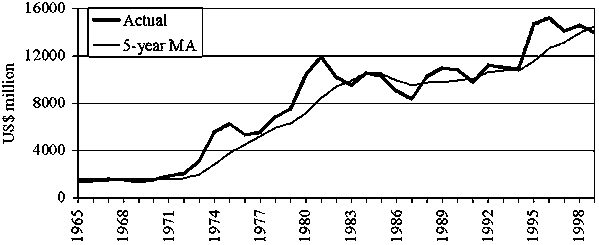
First, there has been a steady increase in food import bills throughout the period, averaging just over 7 percent per annum. The increase was particularly sharp during 1972-1984 (over 11 percent p.a.) and slowed down thereafter (to about 3 percent p.a.). Since the RF concerns the future, e.g. 2002-2012, some upward adjustment would be required to take into account this trend inasmuch as the absolute level of excess imports would be increasing. Thus, for example, a percentage deviation from the moving average level in, say, 2005 would give a much higher excess import bill than the same percentage deviation in 1990.
Second, the data show that there were three distinct occurrences of “spikes” over the entire 35-year period. The first, during the food crisis of the 1970s, lasted for three years (1973-75), when actual food imports were 42 percent above the MA level. The second was in 1980 and 1981 (31 percent above the MA level) and the third was in 1995 and 1996 (a 20 percent excess). This “stochastic” pattern of food imports has implications for the design of the RF: in the sense that the distribution of “excess food import bills” is not normal but positively skewed, i.e. there are some extreme values (spikes) but the chance of their occurring is small.
Also important for the operation of the RF is the number of “consecutive” spikes. During 1965-99, only once did food import bills remain high for three consecutive years (1973-75), whereas the spike lasted for only two consecutive years in the other two periods.
Definition of excess food import bills under various threshold levels
While assumptions can be made about future food import bills and their pattern over the first 10 years over which the RF may be expected to operate, much of the analysis necessarily has to be based on past experience. In view of the marked shift in the trend of food imports in the early 1980s (Figure 1), the analysis below is based on the data for 1985-99. As noted above, some adjustment to the results would have to be made eventually to reflect the future period.
The size of the RF depends on the mean level of excess food imports, their frequency distribution and their sequence of occurrence. Thus, the starting point of the analysis is to define excess import bills.[85]
For any year t, the excess import bill for a given country is the actual level of imports minus (1+a) * MAt, where:
MAt is the moving average value for year (t) calculated as the mean of actual import bills for that year and the previous four years (e.g. it is 1991-95 for the year 1995);The excess values calculated for individual countries are summed up for all the LDCs and NFIDCs concerned to obtain the total excess bill for that year. Estimates of total excess bills are shown in Figure 2 and in Table 1 for various values of a, ranging from 0.10 to 0.35.a is a threshold level and the term (1+a) * MAt measures the food import bill that is not considered excessive and so is covered by the country’s own resources. For example, if a is 0.2, only imports more than 20 percent above the MAt level are considered excessive.
Figure 2. Excess food import bills by threshold levels (annual average 1985 -99)
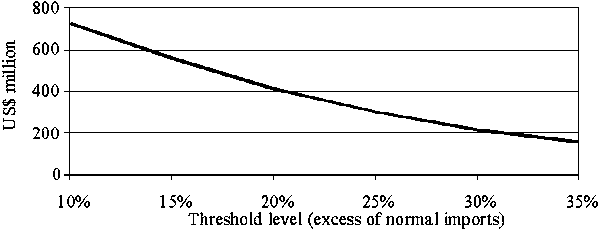
The 1985-99 annual average level of the excess food import bill ranges from US$730 million for a threshold level of 10 percent to US$160 million for one of 35 percent. Thus, the threshold level is the key parameter determining the size of excess food import bills and consequently the size of the RF.
Table 1. Excess food import bills for various threshold
levels assumed
(value in US$ million)
|
Threshold level |
1985-99 |
Spike years |
1985-1999 average |
|
|
1995[86] |
1996 |
|||
|
10 |
729 |
2 338 |
1 780 |
524 |
|
15 |
558 |
1 903 |
1 328 |
395 |
|
20 |
416 |
1 482 |
916 |
296 |
|
25 |
301 |
1 119 |
553 |
219 |
|
30 |
217 |
835 |
354[87] |
161 |
|
35 |
159 |
658 |
270[88] |
122 |
Figure 3. Excess food import bills in 1985-1989 on the basis of a 25 percent threshold level (US$ million)
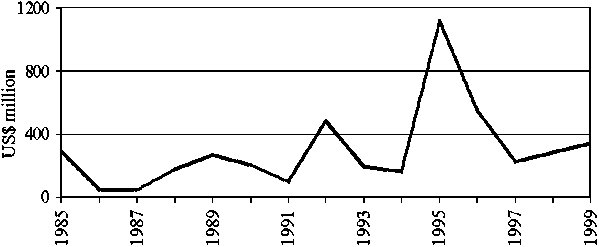
The size of the Revolving Fund
Borrowing and repayment assumptions
The basic characteristic of the RF, which is essential to ensure that the fund remains viable over a sufficiently long period, is that it should be self-financing. Consequently, borrowing countries must assume the obligation to repay their loans.
Under normal conditions, the amount borrowed is assumed to cover 100 percent of a country’s excess import bill. However, in periods of inadequate resources in the RF, the level of borrowing would be capped.
Interest charged on the loan is assumed to be 0.75 percent per annum. Alternatively, different concessional interest rates could be applicable to different eligible countries, depending, for example, on their GNP per capita, or based on the World Bank’s IDA classification. Annexes 2 and 3 show the various lending terms of IMF and IFAD.
The repayment period is assumed to be two years. Thus, an amount borrowed in 2005 would be repaid in full in 2007, together with the interest accrued.
At any year (t), the fund balance, i.e. the balance after disbursements (lending) and receipts (repayment) would be equal to:
Balance (t) = Balance (t-1) - disbursements (t) + receipts (t)Possible interest earnings on the “spare” balance are not taken into account. Conceivably, part of the above balance of the RF can be invested to earn interest at commercial rates, rather than keeping the funds idle. However, whether such interest can be credited to the RF would depend on when contributors transfer funds to it and how the lending and repayment operations are managed. These are difficult matters to consider a priori and thus this aspect (i.e. earnings from spare funds) is not taken into account in the present analysis.
Estimates based on experience of excess import bills in 1985-99
The size and the sequence of the excess food import bills depicted in Figure 3 provide the main basis for estimating the size of the RF. Given the stochastic nature of their distribution, it is inevitable that the excess import bills, and hence the funding needs, would be characterized by several years of “normal” or low levels of borrowing and some years of spikes.
Figure 4 shows the hypothetical sequence of the fund balance for the period 1985-99 (computed as explained above), on the assumption that the RF had been established in 1984, with an initial endowment of US$600 million. On this basis, the fund would have covered the needs until 1992, after which it would have exhausted its resources and, in consequence, would have stopped operating in 1993[89]. Obviously, fresh injections would have been required for the RF to continue operating.
Figure 4. Hypothetical fund balance in 1985-99 with an initial capital of $600 million and 25 percent threshold
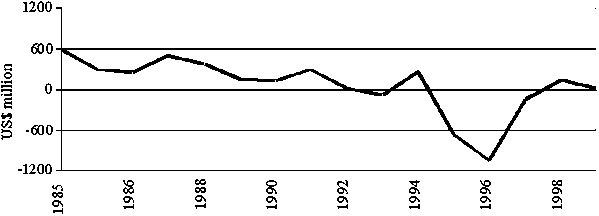
Figure 5 shows what would have happened if such fresh injections had been made in order to avoid funds running out. This case assumes also that positive balances of the RF, as they accumulated, were drawn on to pay back the contributors of such extra injections. Under this “stand-by arrangement”, three fresh injections would have been necessary: $100 million in 1993, $600 million in 1995 and $400 million in 1996. Contributors would have been paid back this total of $1,100 million in two instalments - $800 million in 1997 and $300 million in 1998.
Figure 5. Fund balance in 1985-99 with fresh injections in spike years[90]
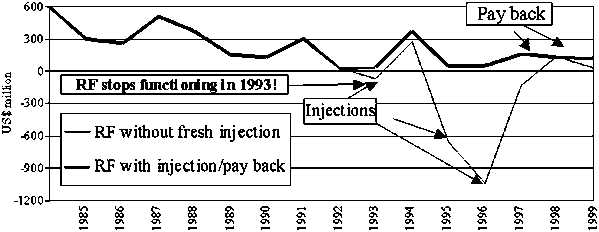
It should be reiterated that under the “stand-by arrangement”, the initial capital of US$600 million is the only contribution expected by contributors. In addition, it is assumed that contributors would have been prepared to make available extra resources on a stand-by basis for spike years. However, these extra injections would have had to be paid back. Hence under this modality of operation, the total net contribution to the RF would have been US$600 million plus the obligation (in the form of “promissory notes” or in some similar form) to provide stand-by resources on loan when spikes occur.
Alternative estimates, assuming other sequencing
Spikes in the very early years of the RF. What would have been the consequences if the spikes such as occurred in 1995 and 1996 had occurred earlier on, say in 1985 and 1986? Such a change in the sequence of shortfalls would not have altered the mean level of the RF, but would have had implications for the timing of fresh injections (and pay-backs). On this hypothesis, fresh injections of US$600 million would have been required in 1985 and US$500 million in 1986. As the borrowings in 1985 would have been repaid in 1987, the RF would quickly have accumulated a large balance, making it possible to repay US$800 million in 1987 and US$200 million in 1988. The remaining US$100 million could have been re-paid only in 1991 in order to keep the RF operating. Thus, basically, the total size of the RF (US$600 million initial capital and US$1 100 million stand-by) would not be affected nor would the nature of the RF change.
Spikes occurring in the middle of the sequence or other years in a random fashion. Neither the total resources of the RF nor the nature of its operation would need to change if the spikes were to occur in the middle of the sequence. This conclusion also holds when the sequences of excess food import bills are generated through Monte Carlo random sampling.
Spikes that last for three consecutive years (as in 1973-75). The food crisis of 1973-75 was the worst for the past four decades. As seen above (Figure 1), the spike was not only sharp but also of unprecedented duration. What would be the consequences for the RF if such a situation were to recur? Simulations show that there would be a need not only for a somewhat larger initial RF (because of an increase in the average annual excess food import bill) but also for bigger injections (over the three consecutive years), but that would not alter the nature of the RF. Moreover, the injection implicit in the third year is small as borrowings during the first year are repaid.
Adjusting the size of the RF for operations in the future
Estimates of the size of the RF discussed above were based on experience in 1985-99, but food imports of the LDCs and NFIDCs have been trending upwards, as was noted above. There is an upward trend in excess food import bills since these are measured relative to a moving average - which rises as actual bills increase.[91] In consequence, some upward adjustment would be required for the size for the estimated initial capital (calculated for the period 1985-99) so as to adequately cover future excess food import bills. Projected trends of food import bills, covering a 10-year future period (e.g. starting in 2002), imply that the initial capital requirement for the 1985-99 period would have to be scaled up by a factor of about 1.6. Thus, if the RF were to be set up with a time horizon of 10 years, the necessary initial capital endowment would amount to about US$1 billion.
As far as the stand-by resources are concerned, it is difficult to speculate on the nature of spikes in the future. What has been established from past data is that there is no trend in the severity of production shortfalls leading to ever-increasing price spikes[92]. There could be a repeat of the 1973-75 situation or things could get worse, although the probability of that happening should be small. In any event, would it be justified to provide sufficient funds to cover such an eventuality? Common sense would suggest that extreme situations require extreme responses - a standard instrument is unlikely to be effective for such situations. Moreover, as noted in Section II, an open-ended commitment is unlikely to be acceptable to contributors and therefore the stand-by component of the RF would need to be capped; an amount of US$1 billion was suggested. Thus, the maximum callable obligation of contributors should remain fixed, i.e. would not exceed US$1 billion during a spike period (which could be of one or multiple years” duration). One capping option is to ration total lending to all potential borrowers in a proportionate manner. Another option would be to introduce an element of special and differential treatment so that borrowing by NFIDCs is capped but not that by LDCs.
Adjustment would also be required if a threshold level other than the 25 percent assumed here were chosen. Figure 2 provides a rough guide to the additional adjustments that would be necessary to the initial capital endowment.
With respect to the stand-by component of the RF to cover spikes, it was pointed out above that there is no way of determining the magnitude of such spikes in the future and that in any event there are practical reasons why a cap would need to be set. Consequently, it would also be necessary to cap borrowings from the RF so that its long-term viability is assured.
Annex 1 - Revolving Fund for the Purpose of Implementing the WTO Marrakesh Decision: Informal Expert Consultation held in Rome on 17 September 2001
List of Participants
IMF
Grant B. Taplin
Special Representative to
the WTO
and Assistant Director,
Office in Geneva.
IFAD
Kwabena Offei Dei
Assistant Controller,
Accounting
Robert Cassani
Coordinator, Resource
Mobilization
Carol Upham
Programme Officer
Supplementary Funds
WFP
Robin Jackson
Senior Policy Advisor
European Commission
André Libens
Principal Administrator
(DG DEV)
FAO
Harmon Thomas
Chief, Commodity
Policy and Projections
Service
Ramesh Sharma
Senior Economist,
Commodity Policy and
Projections Service
Panos Konandreas,
Senior Liaison Officer,
FAO Liaison Office in Geneva
Other Experts
Jim Greenfield
Commodities and Trade Expert,
Rome, Italy
Alberto Valdes
Consultant, Santiago,
Chile
Annex 2 - General Terms of IMF Financial Assistance
|
Facility or policy |
Charges |
Repurchase terms |
||
|
Obligation |
Expectation |
Instalments |
||
|
Stand-by Arrangement |
Basic rate plus surcharge[93] |
3¼-5 |
2¼-4 |
Quarterly |
|
Extended Fund Facility |
Basic rate plus surcharge[94] |
4½-10 |
4½-7 |
Semiannual |
|
Compensatory Financing Facility |
Basic rate |
3¼-5 |
2¼-4 |
Quarterly |
|
Emergency Assistance |
Basic rate |
3¼-5 |
Not applicable |
Quarterly |
|
Supplemental Reserve Facility |
Basic rate plus 300-500 basis points |
2-2½ |
1-1½ |
Semiannual |
|
Contingent Credit Lines |
Basic rate plus 150-350 basis points |
2-2 ½ |
1-1½ |
Semiannual |
|
Poverty Reduction and Growth Facility |
0.5 percent per annum |
5½-10 |
Not applicable |
Semiannual |
|
Memorandum items: |
|
|
|
|
|
Service charge |
0.5 percent |
|
|
|
|
Commitment charge |
25 basis points on committed amounts of up to 100 percent of quota, 10
basis points thereafter |
|||
Note: IMF’s market-related interest rate, known as the "rate of charge", is based on the SDR interest rate which is revised weekly to take account of changes in short-term interest rates in the major international money markets. The rate was about 4 percent in September 2001.Source: IMF (available on the Internet at
http://www.imf.org/external/np/tre/lend/terms.htm)
Annex 3 - Lending Terms and Conditions of IFAD
|
Highly concessional terms
Intermediate terms
Ordinary terms
|
Note: For the purposes of implementing the HIPC Debt Initiative, the IFAD Executive Board may amend the terms upon which an approved loan is provided to a country. In determining the grace period, the maturity date and the amount of each instalment for the repayment of loans, the Executive Board shall take into account an assessment of a country’s debt sustainability produced under the HIPC Debt Initiative.Source: IFAD Lending Policies and Criteria (available on the Internet at
http://www.ifad.org/pub/basic/lending/e/02polcri.pdf)